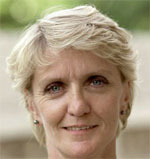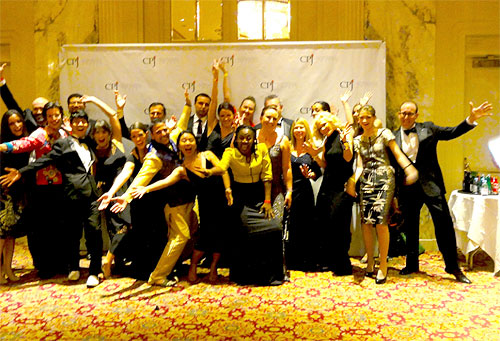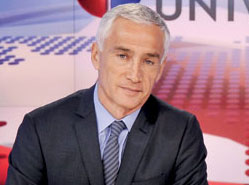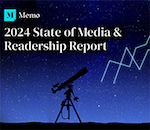The annual dinner of the Committee to Protect Journalists, the “1% of the 1% of U.S. journalism,” had its Waldorf blowout last week, the same week that CareerCast dubbed newspaper reporter the worst of 200 jobs that it ranks.
The contrast could hardly have been starker. A black-tie crowd of 1,000, including the 27 CPJ staffers, dined on the finest Waldorf cuisine. About five working press were confined to the balcony where they had cold cuts, cheese and soft drinks. If any of them but us wrote stories, we have yet to see them.
 |
It’s not as though CPJ is pressed for funds. Revenues exploded 93.5% to $7.2M in 2014 from $3.7M in 2013. The gain was from “contributions and grants” which grew 95% to $6,331,771 from $3,247,036. We have asked CPJ for an explanation but it answers few questions.
The gush of funds boosted CPJ’s net assets 12.8% to $16.7M. They include $11.7M in stocks and bonds.
The new revenue total meant that pay packages of staffers, totaling $2,719,929 in 2014 and averaging $100,078, took 37.6% of revenues. The $2,394,937 payroll of 2013 amounted to 64% of revenues, far above the usual 35%-45% staff pay proportion of non-profits. Executive director Joel Simon had a salary of $206,039.
Are Reporters “Advocates” or Not?!
Contrasting views of reporters’ duties were presented by the 2015 and 2014 winners of the Burton Benjamin Award for lifetime achievements in journalism.
The 2015 winner, Kathy Gannon, who spent more than 20 years in the Middle East for the AP, was seriously wounded by “friendly fire” on April 4, 2014 in Afghanistan.
Journalists, she said, (click for full speech) “are the champions and guardians ONLY (her caps) of the right to ask questions, investigate, understand and disseminate information…it is about choosing to dig deeper, ask tough questions, researching and understanding our subject…it is about refusing to be intimidated and having the courage to step away from that ‘good vs. evil’ precipice that has at times tainted reporting, and impacted how conflicts are covered.”
“It is not about being an advocate, a torch bearer of human rights of a crusader for some vaguely laid out set of values that is so often linked to the West, as if we have a monopoly on all that is good and right,” she said.
 |
Gannon was shot six times and photographer Anja Niedringhaus was killed when an Afghan police officer, who supposedly was protecting them, opened fire on their car.
Her message was poles apart from the one delivered at the CPJ dinner last year by Univision and Fusion anchor Jorge Ramos who was the 2014 Burton Benjamin winner.
“I think the best journalism happens when we stop pretending that we are neutral and recognize that we have a moral obligation to tell the truth to power,” he said. “Reporters must get the facts straight but they must also side against oppression. This could be dictators or “politicians abusing their power,” he said.
Ramos, who was escorted from a Donald Trump press conference Aug. 25 by a uniformed guard, said “The best of journalism happens when we take a stand: when we question those who are in power, when we confront politicians who abuse their authority, when we denounce an injustice…when we side with the victims, the most vulnerable, with those who have no rights…when we purposely stop pretending that we are neutral and recognize we have a moral obligation to tell truth to power.” He also said "Silence is the enemy of journalism."
Ramos had irked Trump by criticizing his anti-immigration policies.
 |
Gannon thanked AP CEO Gary Pruitt and others at AP “who have been so much more than my employer.” AP is a perennial sponsor of PRSA’s annual conference which refuses to allow an exhibit of O’Dwyer products. Attempts to interest Pruitt, a lawyer, in PRSA’s O’Dwyer boycott have gone nowhere.
Despair Grips World of J
At about the same time that CPJ attendees were feasting at the Waldorf, CareerCast came out with its annual ranking of the best and worst jobs, again putting “newspaper reporter” at the bottom.
The flight of readers from print to online crashed ad revenues, CareerCast notes. “Poor job prospects, low pay and layoffs have plagued the newspaper industry for years.”
However, it says that many of the lowest ranked jobs, in terms of pay, stress and/or dangers, benefit society. These include, besides reporting, military soldier, corrections officer and firefighter. So if you want to be a model citizen and becoming rich is not one of your goals, you can pick such careers.
Consider PR is CareerCast’s advice. Skills such as “talking to complete strangers and writing clean copy on a tight deadline can be especially valuable in fields such as PR and marketing,” it says.
PR’s Outnumber Press; Resistance Stiff
Those working in communications on the corporate and agency side now outnumber those in journalism by about five-to-one, according to stats of the U.S. Dept. of Labor. Students thinking of a J career need to be aware of this. Ingenuity is required to sidestep various barriers.
Companies and institutions have stiffened their resistance to Roto-Rooter types of analysis by reporters and even casual coverage. The CPJ itself is a good example of this.
Although championing the rights of reporters to be able to cover institutions, the CPJ works hard at keeping a low profile for itself.
Having its dinner on the Tuesday night before Thanksgiving cuts the potential audience because of the two-day holiday. By the time people return to their normal routines the next Monday, the CPJ dinner is old news.
Not pitching the mainstream press hard is another tactic. The New York Times may run a couple of photos of the event a week or two later. No mainstream coverage of this year’s event appeared the next day.
“Credentialing” Is a Barrier
CPJ requires “credentials” of reporters and only allows one per medium. The International News Safety Institute, Brussels, says journalist freedoms should not depend on “accreditation” by entities being covered since that restricts the “liberty” of journalists.
The O’Dwyer Co., dissatisfied with again being exiled to the balcony, sought a place on the ballroom floor in advance of the dinner. No food was desired.
We emailed Sheila O’Shea, director of marketing and PR of Hearst, since Hearst CEO Steven Swartz was chair of the dinner.
We noted we were not just “another news medium” but the only one that covered last year’s dinner with pictures and extensive copy the next day. It doesn’t look good for a group that champions press access to indulge in the very press-blocking practices that it condemns, we told O’Shea. We topped this off by noting we were once a “Hearstling,” reporting for Hearst’s New York Journal-American from 1961-67.
Our arguments fell on deaf ears as they did with Van Scott Jr., ABC News publicity director. ABC-TV anchor David Muir was emcee of the dinner and we thought he might have the clout to get us a place on the ballroom floor—not including dinner or drinks. No dice, said Scott.
Those contemplating a reporting career must realize that considerable creativity and ingenuity will be needed to get past corporate and institutional gatekeepers.
Critics of CPJ, with its treasury of $16M and 27 staffers, feel it should turn some of its attention to the plight of the U.S. press. A disturbing development is the proposed sale of Cablevision, Newsday and news12longisland.com to Altice, a French-owned company.


 Trump Media & Technology Group today reported a $58.2M net loss on $4.1M in 2023 revenues, a disclosure that drove its stock price down 22.6 percent to $47.96.
Trump Media & Technology Group today reported a $58.2M net loss on $4.1M in 2023 revenues, a disclosure that drove its stock price down 22.6 percent to $47.96. Barry Pollack, an attorney at Wall Street’s Harris St. Laurent & Wechsler, has registered Julian Assange as a client with the Justice Dept. “out of an abundance of caution.”
Barry Pollack, an attorney at Wall Street’s Harris St. Laurent & Wechsler, has registered Julian Assange as a client with the Justice Dept. “out of an abundance of caution.” Paramount Global to slash 800 jobs in what chief executive Bob Bakish calls part of an effort to “return the company to earnings growth"... Rolling Stone editor-in-chief Noah Shachtman is exiting at the end of the month due to disagreements with chief executive Gus Wenner over the direction the magazine is taking... The New York Times broke the $1 billion barrier in annual revenue from digital subscriptions in 2023... Press Forward is investing more than $500 million to strengthen local newsrooms.
Paramount Global to slash 800 jobs in what chief executive Bob Bakish calls part of an effort to “return the company to earnings growth"... Rolling Stone editor-in-chief Noah Shachtman is exiting at the end of the month due to disagreements with chief executive Gus Wenner over the direction the magazine is taking... The New York Times broke the $1 billion barrier in annual revenue from digital subscriptions in 2023... Press Forward is investing more than $500 million to strengthen local newsrooms. The majority of news articles are read within the first three days of publication, according to a recent report.
The majority of news articles are read within the first three days of publication, according to a recent report. The Los Angeles Times gives pink slips to 115 people or 20 percent of its newsroom staff... TIME is also laying off about 30 employees, which is approximately 15 percent of its editorial staff... The Baltimore Banner, which was launched by Stewart Bainum in 2022 after he failed to buy the Baltimore Sun, added 500 subscribers per day in the three days following Sinclair Broadcast Group's deal to purchase the Sun.
The Los Angeles Times gives pink slips to 115 people or 20 percent of its newsroom staff... TIME is also laying off about 30 employees, which is approximately 15 percent of its editorial staff... The Baltimore Banner, which was launched by Stewart Bainum in 2022 after he failed to buy the Baltimore Sun, added 500 subscribers per day in the three days following Sinclair Broadcast Group's deal to purchase the Sun.


 Have a comment? Send it to
Have a comment? Send it to 
No comments have been submitted for this story yet.